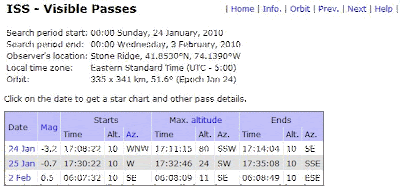Friday night, my whole family went out onto the back deck to watch the incredibly bright International Space Station (ISS) zip overhead passing close to the 1st quarter moon (to be honest, my kids were complaining because we ripped them away from a Nintendo DS game, but too bad, my wife and I enjoyed watching it).
It's easy to get satellite flyover predictions if you know where to look. I use a website called Heaven's Above.
On the web site, you have to choose your location (the default is 0 latitude, 0 longitude - a location off the west coast of Africa). You don't need to know your latitude or longitude, however. Let's suppose you live in Stone Ridge, Ulster County, NY. Under Configuration, click Select from database and you'll get a list of countries. Select United States and then it asks you to enter your town name. Enter Stone Ridge (do not enter the state). The database will return a list of three Stone Ridges, two in New York and one in Tennessee. Choose the one in Ulster County, NY (latitude 41.853, longitude -74.139 which translates to roughly 42 N, 074 W).
When you select your location, you go back to the main Heaven's Above website with data custom tailored for your backyard. Let's see when the ISS will be passing over. Under Satellites, click the 10 day prediction for the ISS. Here's what I received for Stone Ridge, NY on January 24, 2010.
Sometimes you'll get a long list, sometimes a short one (like this), and sometimes nothing. It all has to do with the orbital characteristics of the ISS. I'll explain why this is so in a bit. First note the header material at top. One important piece of information is tht the times are all local time (Eastern Standard Time - EST) which makes things easy. Note that today, January 24, the ISS will be visible starting at 5:08 (17:08:22 is 17 hours, 8 minutes, 22 seconds where 17 hours is 5 pm in 24-hour format). The maximum altitude of the ISS will be at 5:11 pm, and it will disappear at 5:14 pm. So the flyby will last about 6 minutes total.
Alt and Az refer to where the ISS will be at those various times. Alt is altitude above the horizon where the horizon is 0 degrees and the zenith (the point directly over your head) is 90 degrees. So, at its maximum altitude, the ISS will be 80 degrees up which is nice and high overhead. Azimuth is simply the compass direction. The ISS will initially appear in the west-northwest (WNW) and disappear in the southeast (SE). So you do need to know some basic directions in your backyard to know where to look (this time of year, the sun sets in the southwest).
Also, note the Mag. column which reads -3.2 for today. That's magnitude which refers to how bright astronomical objects appear in the sky. The system dates back to the ancient Greek astronomer Hipparchus and the lower the number, the brighter the object. Magnitude 6 is for barely visible stars (it's about the limit of naked-eye seeing), the north star is 2 (kind of average), Vega is 0, and Sirius, the brightest star we can see, is around -1.5 (negative magnitudes are brighter than positive ones). Venus can reach magnitude -4.4 and the full Moon is around -12.7. So, when the ISS is -3.2, it means it's brighter than the brightest star (Sirius) but not quite as bright as Venus at its closest - that's pretty bright!
Another neat thing about this ISS prediction is that if you click on the date, which is a link, you get a star chart with the ISS path on it (note how it passes close to the Moon again).
If your familiar with some of the constellations, this can help you spot the ISS as it moves overhead. Try it sometime, it's a fun thing to get the prediction, go outside, and then actually spot the ISS (there's people up there in that tin can!). The Heaven's Above website also gives other satellite predictions so even if the ISS isn't visible there is always something you can look for (although they won't be as bright). It's neat to see a satellite and tell people that it's SeaSat 1, an ocean observation satellite launched back in 1978.
So why can we see satellites? They don't have lights on them like planes do but instead they are orbiting so high up that for an hour or so after the sun sets and an hour or so before it rises in the morning, the satellite is up in bright daylight while we're in darkness on the ground. Light reflects off the metallic surfaces of the satellite making it visible to us. The ISS orbits the Earth every 90 minutes or so but we can only see it when it passes overhead during those windows of time. If it's overhead in the middle of the night, we simply won't see it because it's in darkness too.





No comments:
Post a Comment